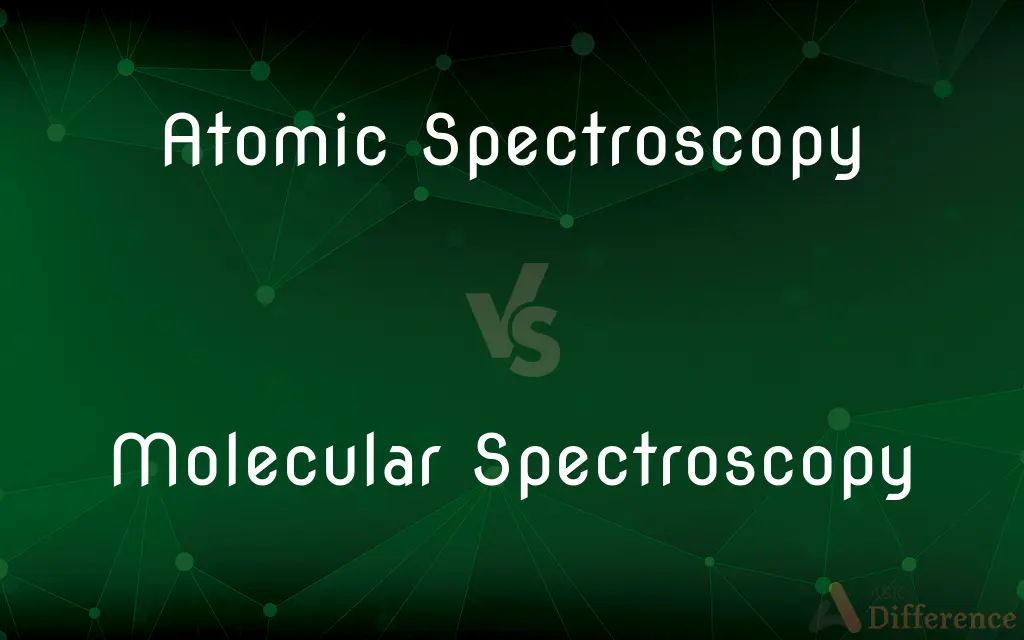Atomic Spectroscopy vs. Molecular Spectroscopy — What's the Difference?
By Urooj Arif & Maham Liaqat — Published on March 22, 2024
Atomic spectroscopy identifies elements via light absorption, emission, and fluorescence. Molecular spectroscopy examines chemical structures and bonds through electromagnetic interactions.

Difference Between Atomic Spectroscopy and Molecular Spectroscopy
Table of Contents
ADVERTISEMENT
Key Differences
Atomic spectroscopy involves studying isolated atoms, often in a gaseous state, by observing the absorption or emission of electromagnetic radiation at specific wavelengths. This technique is pivotal in identifying and quantifying elemental compositions in various samples. It relies on the fact that each element has a unique electronic structure, allowing it to absorb or emit light at characteristic wavelengths.
Molecular spectroscopy, on the other hand, examines the interaction between electromagnetic radiation and molecules. It provides insights into molecular structures, bonding environments, and the dynamics of chemical reactions. Molecular spectroscopy encompasses a broader range of techniques, each based on different types of molecular energy transitions, such as vibrational, rotational, and electronic. Common methods include Infrared Spectroscopy (IR), Nuclear Magnetic Resonance (NMR) Spectroscopy, and Ultraviolet-Visible (UV-Vis) Spectroscopy.
The key difference lies in their focus and applications. Atomic spectroscopy is primarily used for elemental analysis, making it crucial in fields like environmental monitoring, material science, and forensic analysis, where precise elemental composition and concentration are required. Molecular spectroscopy is indispensable in organic and inorganic chemistry, biochemistry, and pharmaceuticals, offering detailed information on molecular structure and chemical bonding.
Atomic spectroscopy techniques are characterized by their ability to detect and quantify trace elements with high precision and sensitivity. Molecular spectroscopy, with its diverse techniques, provides comprehensive information on molecular geometry, functional groups, and chemical environments, facilitating the understanding of complex biological mechanisms and the development of new materials and drugs.
Atomic spectroscopy offers unmatched precision in elemental analysis, while molecular spectroscopy provides a window into the intricate details of molecular structure and interactions. Both play indispensable roles in advancing scientific knowledge and technological development across a wide spectrum of disciplines.
ADVERTISEMENT
Comparison Chart
Focus
Individual atoms
Molecules
Information Obtained
Elemental composition
Chemical structure, bonds, dynamics
Techniques
AAS, AES, ICP-OES
IR, NMR, UV-Vis
Applications
Elemental analysis, environmental science
Organic chemistry, biochemistry, pharmaceuticals
Interaction Type
Absorption, emission of light at specific wavelengths
Interaction with various electromagnetic radiation frequencies
Sample State
Often gaseous
Various states (solid, liquid, gas)
Analysis Precision
High precision and sensitivity for elements
Detailed molecular structure and bonding
Key Use
Trace element detection
Identifying functional groups, molecular geometry
Compare with Definitions
Atomic Spectroscopy
Often requires atomization of samples.
Samples are vaporized for analysis in AES to determine elemental compositions.
Molecular Spectroscopy
Explores molecular structures and bonding.
IR spectroscopy identifies functional groups in organic compounds.
Atomic Spectroscopy
Critical in material and environmental sciences.
Monitoring air pollution levels through elemental analysis.
Molecular Spectroscopy
Based on molecular energy transitions.
NMR spectroscopy provides insights into the molecular structure of pharmaceuticals.
Atomic Spectroscopy
Identifies elements by their unique light absorption/emission.
AAS is used to measure lead levels in water samples.
Molecular Spectroscopy
Offers comprehensive chemical insights.
Determining the reaction mechanisms in catalysis through molecular spectroscopy.
Atomic Spectroscopy
Highly sensitive to trace element detection.
Trace arsenic in food products is quantified using atomic spectroscopy.
Molecular Spectroscopy
Encompasses a wide range of techniques.
UV-Vis spectroscopy is used to study the electronic transitions in molecules.
Atomic Spectroscopy
Utilizes the unique electronic structure of atoms.
ICP-OES analyzes metal content in soil samples.
Molecular Spectroscopy
Vital for chemical and biological research.
Investigating protein-ligand interactions using spectroscopic methods.
Common Curiosities
Why is molecular spectroscopy important in pharmaceuticals?
It helps in identifying the chemical structure, purity, and composition of drug compounds, crucial for drug development and quality control.
Are these spectroscopic methods applicable to all types of samples?
Yes, both atomic and molecular spectroscopy can analyze diverse samples, but sample preparation and the specific technique used may vary depending on the sample's nature and the information sought.
What distinguishes atomic from molecular spectroscopy?
Atomic spectroscopy focuses on analyzing individual atoms to determine elemental compositions, while molecular spectroscopy examines molecules to understand their structure and chemical bonding.
Can molecular spectroscopy reveal the dynamics of chemical reactions?
Yes, techniques like time-resolved spectroscopy can track changes in molecular structures during chemical reactions, providing insights into reaction mechanisms.
Can atomic spectroscopy identify molecules?
No, atomic spectroscopy is designed to identify and quantify elemental compositions, not molecular structures.
What role does NMR spectroscopy play in molecular spectroscopy?
NMR spectroscopy provides detailed information about the structure, dynamics, and environment of molecules, essential for understanding complex molecular systems.
How do environmental scientists use atomic spectroscopy?
They use it to detect and quantify trace elements in environmental samples, such as water, soil, and air, monitoring pollution and assessing environmental health.
How does atomic spectroscopy achieve high sensitivity?
By measuring the precise wavelengths of light absorbed or emitted by atoms, enabling detection of trace amounts of elements.
What advancements have been made in spectroscopic techniques?
Recent advancements include improvements in sensitivity, resolution, and the development of non-destructive methods, expanding the applications of spectroscopy in various fields.
Is specialized training required to perform spectroscopic analysis?
Yes, operating spectroscopic instruments and interpreting results require specialized training and knowledge in the field.
Share Your Discovery

Previous Comparison
Timing Belt vs. Serpentine Belt
Next Comparison
Bi-Weekly vs. Accelerated Bi-WeeklyAuthor Spotlight
Written by
Urooj ArifUrooj is a skilled content writer at Ask Difference, known for her exceptional ability to simplify complex topics into engaging and informative content. With a passion for research and a flair for clear, concise writing, she consistently delivers articles that resonate with our diverse audience.
Co-written by
Maham Liaqat















































